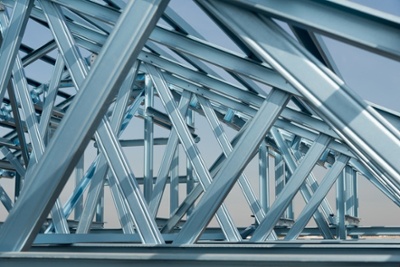Eco-friendly Interior Design Materials: Is Steel Sustainable?
 Is steel a sustainable material? Incredibly so.
Is steel a sustainable material? Incredibly so.
It’s also available in multiple forms -- stainless, galvanized, carbon, and mild. Each has a different aesthetic and slightly different physical properties for your application. Overall, it’s a great structural and decorative material for architecture, as well as a sturdy industrial and construction material.
However, truly sustainable steel requires consistent practices from the manufacturer and the fabricator. Otherwise, it can defeat the original intent by adding excess energy, byproducts, and waste.
There are four main reasons steel and green design were meant to be together.
What makes steel an eco-friendly interior design material?
Steel is one of the most eco-friendly interior design materials because:
- Due to its strength, you don’t need a lot to do the job
- It’s endlessly recyclable -- some steel mills only use scrap to produce new steel
- There’s relatively little energy used to produce it
- It’s not toxic to humans or the environment
1. A Little Goes a Long Way
Compared to other building materials, it doesn’t take a lot of steel to hold up a building. Even though structural steel is mainly higher carbon plain steel, all types of steel are strong and highly durable in any form (stainless, carbon, galvanized, mild).
And, due to its sustainability, you can also create an entire building out of steel if it strikes your fancy, including:
- The structure itself
- Doors and windows
- Exterior cladding systems
- Decorative architectural and design interiors (decorative metal trim for furniture, base trim for high-traffic corridors, etc.)
2. Endless Recyclability
Steel is the world's most recycled material. Steel is unique in that it can be recycled without losing any of its famous strength or durability. It can be recycled at any point in its life or application. Even cut pieces and rejected components can easily be recycled after fabrication.
Steel constructions and steel-framed buildings can be dismantled, and the metal reused. Designers can take a measure of responsibility for sustainability by practicing “design for deconstruction,” making it more efficient to dismantle and reuse the metal.
3. Little Manufacturing Energy & Waste
With advances in manufacturing technology, the energy required to produce raw steel has dropped 60% since 1960.
Even further, there are many innovative ways manufacturers are making steel more sustainable.
- By-product gases from the furnaces can be fully reused. They’re used as a direct fuel substitute, for internal generation of electricity, or sold for power generation. Flaring is a last resort.
- CO2 byproducts can now be recaptured, cleaned up, and used to make carbonated drinks.
- Electric arc furnaces (EAFs) allow steel production from 100% scrap metal. Producing steel from scrap uses much less energy than producing new steel.

The World Steel Association predicts that “Medium-term energy efficiency improvements in the steel industry are expected through technology transfer, or applying best-available technology to outdated steel plants worldwide.”
Further, waste and by-products produced in the manufacturing process can be reused by the construction industry.
4. No Damage to Humans & Environment
Steel releases no harsh chemicals or toxins, and can easily be retrieved from the environment with magnets. This makes its impact on the environment minimal compared with many other materials, especially when you consider that it produces no toxic run-off.
This is good for humans too, especially when you consider how many people use stainless steel cooking utensils at home.
Why Is Sustainability Important in Interior Design?
Buildings are responsible for 1/3 of global greenhouse gas emissions.
With environmental issues under the microscope more than ever, sustainability is gaining momentum among businesses and your fellow designers. To some, it's a competitive tool at this point. Are you ready?
By sticking to sustainable interior design materials, you'll look like a rock star to firms and individuals who value such thinking. Interior designers have immense power to affect sustainability in buildings -- many design choices that affect sustainability are made early in the process.
Are You Buying Truly Sustainable Interior Design Products?
Is steel sustainable? Yes, with a caveat. Some manufacturers don’t make the effort to use clean processes, dispose of waste properly, or reuse materials and scrap.
If the producer and the fabricator don’t follow strict procedures regarding reuse, waste disposal, and other key operations, the above points are moot. A material is only as sustainable as we make it -- vet your vendor and their sources carefully.
(Editor's note: This article was originally published in August 2017 and was recently updated.)
You May Also Like
These Related Stories

Decorative Metal Trim Mouldings vs. Wood Mouldings

Beyond Beauty: Modern Steel Windows Qualities & Standards




